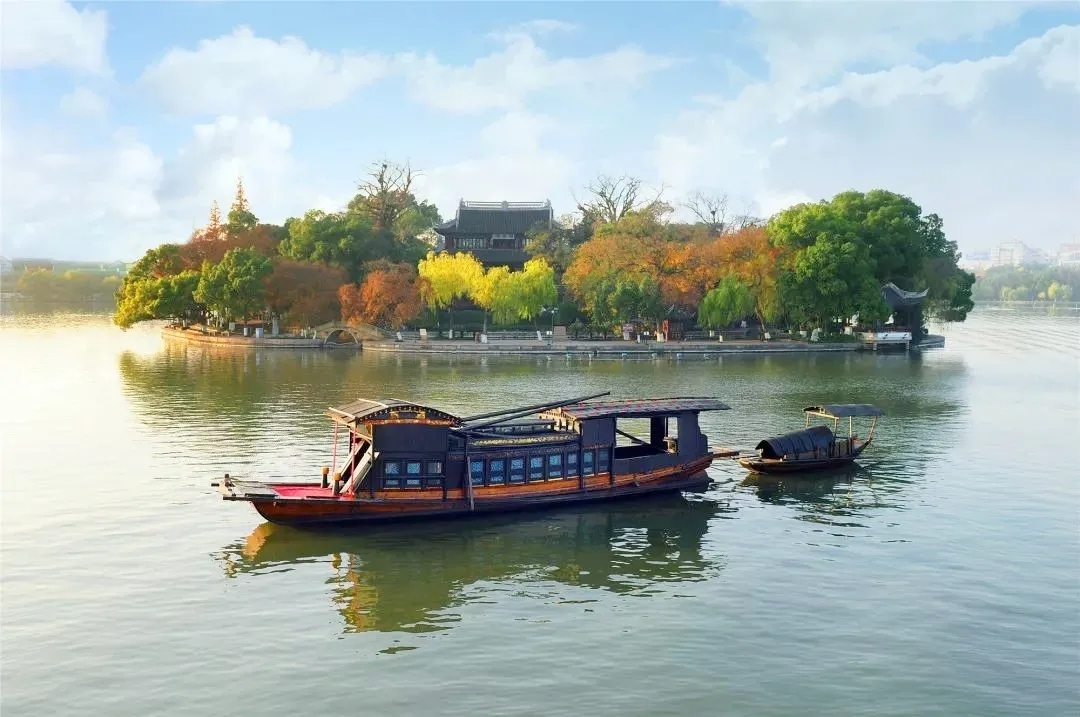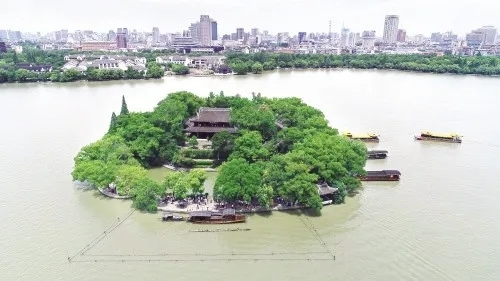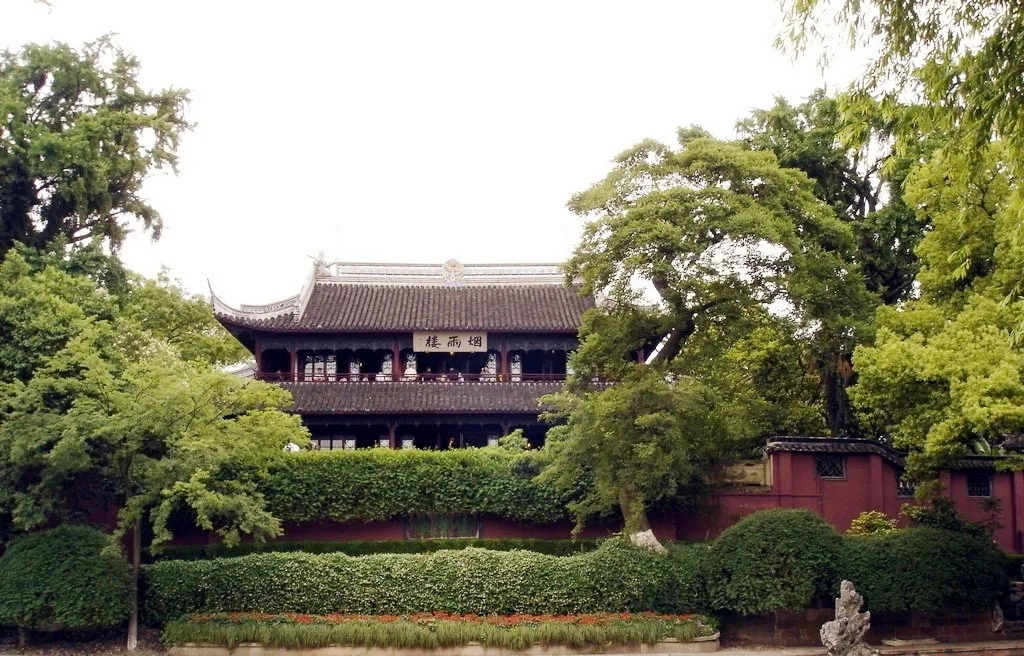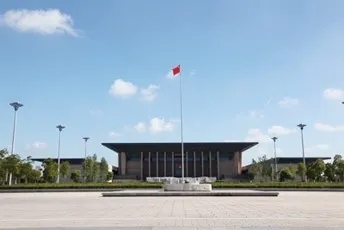百年党史悟初心 梦想红船再起航②| 红船与南湖 Red Boat and Nanhu Lake
100年前,中国共产党在浙江嘉兴南湖的红船上诞生。从那时起,中国共产党历经百年风雨,由一叶红船发展成为领航中国行稳致远的巍巍巨轮。可以说,“红色根脉”是党在浙江百年奋斗最鲜明的底色。作为中国革命红船起航地、改革开放先行地、习近平新时代中国特色社会主义思想重要萌发地,浙江在党史学习教育中有着特殊的地位与优势。把学习“红船精神”与学习党史充分结合起来,对我们守好“红色根脉”,扛起“五大历史使命”,学党史、悟思想、办实事、开新局具有重要意义。
为此,我们特别开设了“百年党史悟初心 梦想红船再起航”系列专栏。和大家一起重读红船故事,以党史学习教育赋能“重要窗口”建设,以学思践悟的新境界迎接建党100周年 。今天,我们推出第二期《红船与南湖》。
第二期 红船与南湖
Red Boat and Nanhu Lake
嘉兴地处浙江省东北部,东接上海,北邻苏州,西连杭州,南濒杭州湾,陆域面积4223平方公里,海域面积1523平方公里。嘉兴区位优越,经济发达,是长江三角洲重要城市之一。
Jiaxing is located in the northeast of Zhejiang. With Shanghai to the east, Suzhou to the north, Hangzhou to the west and Hangzhou Bay to the south, Jiaxing covers a land area of 4223 square kilometers and a sea area of 1523 square kilometers. Its favorable geographical position and well-developed economy make it one of the most important cities in the Yangtze River Delta region.
南湖位于嘉兴市区东南部,风景秀丽,分为东西两湖,两湖相连形似鸳鸯交颈,古时湖中常有鸳鸯栖息,因此又名鸳鸯湖。宋代以后,嘉兴南湖与杭州西湖、南京玄武湖并称为江南三大名湖。
Nanhu Lake, which is located in the southeast of Jiaxing City, boasts charming scenery. The lake is separated into two sections, one to the west and one to the east, and together, they have the appearance of two mandarin ducks with their necks crossed over each other. Beginning in the Song Dynasty, Nanhu Lake in Jiaxing, together with Xuanwu Lake in Nanjing and West Lake in Hangzhou, were dubbed as the “Three Renowned Lakes” in the regions of the Yangtze River.
Photo by Sheng Jiansheng
In early August of 1921, the First National Congress of the CPC was concluded on a boat in Nanhu Lake. It was where the CPC was formally established. Thus, the Chinese Revolution set sail from Nanhu Lake, and Jiaxing became the birthplace of the CPC.
湖心岛位于南湖中心,全岛面积18亩。明嘉靖二十七年(1548年),嘉兴知府赵瀛组织疏浚城河,将淤泥垒土成岛,次年移建烟雨楼于岛上。清以后又相继建成清晖堂、宝梅亭、御碑亭等其他建筑,形成了以烟雨楼为主体的古园林建筑群,是典型的江南园林。
Huxin Island is located in the center of South Lake and covers an area of 1.2 hectares. In 1548, Jiaxing prefectural magistrate Zhao Ying arranged for a dredging of the city's rivers. The resulting accumulation of sediment was piled into an artificial island in the center of Nanhu Lake on which the Yanyu Pavilion was built the following year. Beginning in the Qing Dynasty, more buildings were erected, such as Qinghui Hall, Baomei Pavilion and Imperial Stele Pavilions. The cluster of buildings, with the Yanyu Pavilion as the focal point, made the island into a classic Jiangnan park.
烟雨楼是嘉兴南湖湖心岛上的主要建筑,现已成为岛上整个园林的泛称。烟雨楼,因唐朝诗人杜牧“南朝四百八十寺,多少楼台烟雨中”的诗意而得楼名。烟雨楼正楼,楼两层,重檐画栋,朱柱明窗,在绿树掩映下,更显雄伟。清代乾隆帝六下江南,八次登临烟雨楼,先后赋诗20余首,盛赞烟雨楼美景。
Yanyu Pavilion is the main structure on Huxin Island, and it has even become an informal name for the island. The inspiration for the name of the Pavilion comes from the verse by the TangDynasty poet Du Mu: “Of the 480 temples of the Southern Dynasties, many are shrouded in mist and rain.” The main structure of the two-story pavilion has double eaves, red columns, and windows that admit a fair amount of light. The shade of trees nearby gives it an especially majestic feel. During his six visits to southern China, Qing Emperor Qianlong visited the Yanyu Pavilion eight times and was inspired to write over 20 poems in praise of its beauty.
南湖革命纪念馆成立于1959年,是嘉兴南湖中共一大会址的宣传、保护、管理机构。建馆之初,纪念馆馆址设在南湖湖心岛上,借用湖心岛古建筑作为举办党史展览的场所。为更好地保护、利用南湖的政治资源,2005年10月,南湖革命纪念馆获批扩建,新馆于2011年建党九十周年之际正式对外开放。纪念馆自成立以来,通过接受捐赠、征集、购买等方式不断充实馆藏,现有藏品总数达到1万余件,有革命文物、珍贵文献、书画珍品等,具有一定的研究和珍藏价值。
图片来源:南湖革命纪念馆官网
Established in 1959, the Nanhu Revolutionary Memorial Hall in Jiaxing is the promotion, protection and management institution of the site of the First National Congress of the CPC. In its initial stage, the hall was located on the Huxin Island, with its collections exhibited in the ancient buildings on the island. To better protect and utilize the resources of the Nanhu Lake, Nanhu Revolutionary Memorial Hall was given approval to expand its venue. So, in 2011, a new museum was opened to the public to mark the 90th anniversary of the founding of the CPC. Since its establishment, the Nanhu Revolutionary Memorial Hall has continued to expand its collection through the acquisition of historical objects and the bequest of charitable donors. Presently, the museum houses more than 10,000 artifacts, including revolutionary relics, precious documents, as well as valuable paintings and calligraphy works.
参考来源:《红船精神:起航的梦想》
供稿:礼宾协调处(翻译室)
转载请注明:浙江外事





